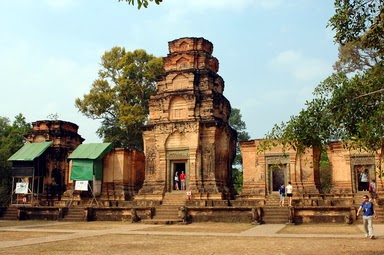Prasat Kravan, Srah Srang and Banteay Kdei
12 Feb 2014
This is the first day of our visit to Angkor Archaeological Park. What did we start with? Certainly the purchase of the ‘Angkor Pass’. Options are: 1 day ($20), 3 days ($40) and 7 days ($60). We went for 7-day. Then we were arranged to take a photo. Just very quick, we’ve got our passes with the photo. Efficient! It came with a strap to wear round the neck. It must be shown at all times.
Our first site visit point: Prasat Kravan. It is a temple with five brick sanctuaries built in 10th century devoted to Vishnu. They are unusually arranged in one N-S row, facing E and all on the same platform. Today only the central and S have a superstructure, consists of receding tiers, each diminishing in height and proportion to enhance the impression of scale. The temple was restored in the 1960s based on what remained at that time.
The outlook of the sanctuaries is not impressive. But they contain very fine interior brick
bas-reliefs. They are the only known examples
of their type in Khmer art. Figures were carved into the brick.
Srah Srang is a baray located south of the East Baray and east of Banteay Kdei. It was dug in the mid-10th century and remodelled in late 12th century. It is now a sandstone terrace over the water. It offers a beautiful and tranquil view. Srah Srang is a popular site for viewing the sunrise. We passed by there one evening and had a beautiful sunset.
Banteay Kdei
is a smaller version of Ta Prohm and Preah Khan. It is a Buddhist
temple built in late 12 to early 13 century.
Probably, it was built over the site of an earlier temple dated from 10
century.
Banteay Kdei means ‘A Citadel of Chambers’. Its structures are contained within two successive enclosure walls, and consist of two concentric galleries. My very strong impression is: apsaras all over the place.
Certainly, there are other figures, e.g. guardians.


















Comments